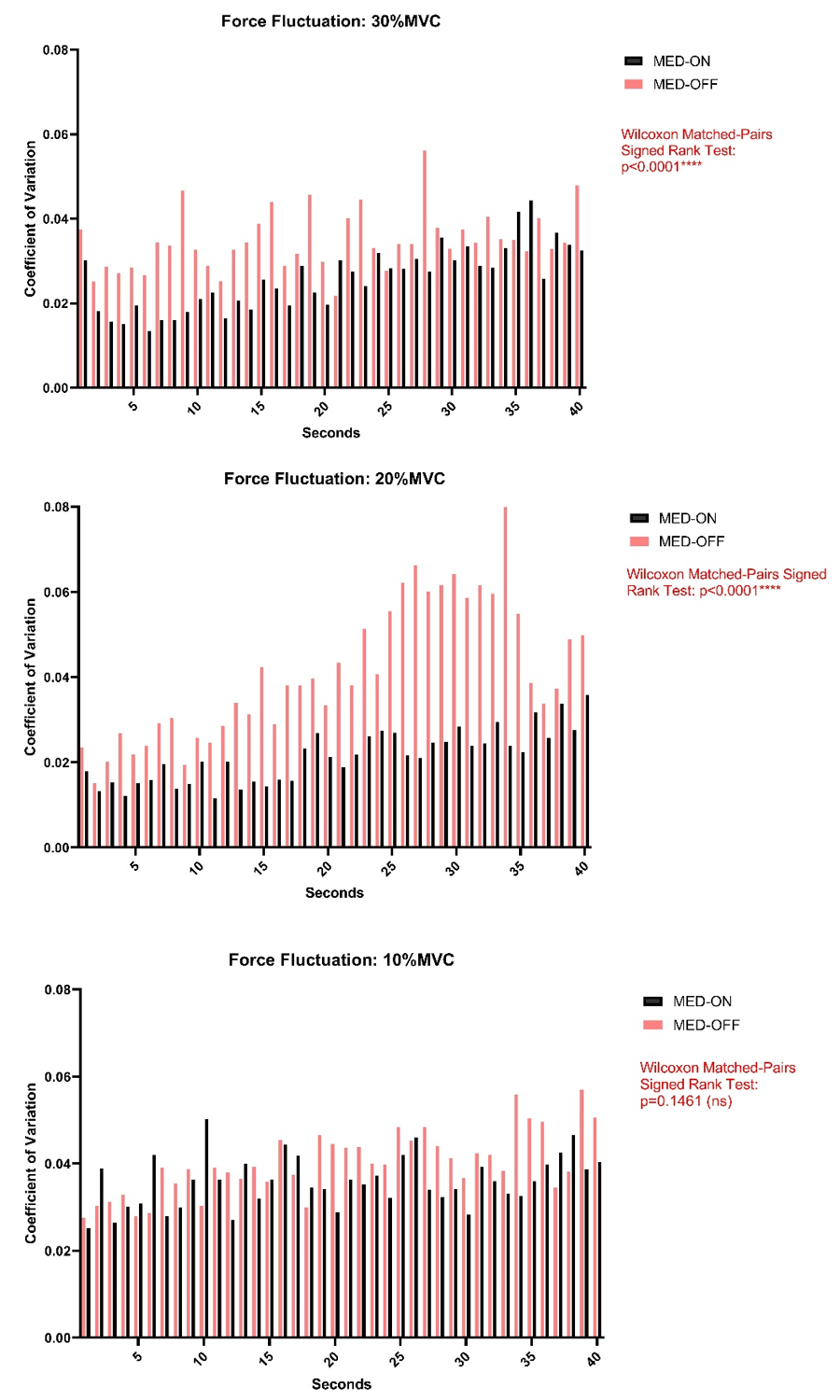Category: Parkinson's Disease: Neurophysiology
Objective: To quantify and compare muscle force variability during isometric dorsiflexion in male patients with Parkinson’s Disease (PD), in the ON- versus OFF-medication state.
Background: Force control is impaired in PD patients compared to controls [1-3]. Previous research has demonstrated that the ability to control a sustained muscle contraction is impaired in females with PD, and that dopaminergic medication may help normalize such force control [4]. In effect, we sought to elucidate if we could extend these findings to a male cohort. We hypothesized that dopaminergic medication would improve force control in male PD patients. Force variability in male PD patients during a sustained dorsiflexion task was quantified and compared in the ON and OFF state at relatively low and moderate force levels.
Method: We measured the isometric dorsiflexion force at the ankle in four male PD patients (median age: 62; median disease duration: 3.75 years) in the ON and OFF state. Maximum voluntary force (MVF) was recorded OFF-med, and sub-MVF levels (10%, 20%, 30%) were assessed. Patients were asked to follow a trapezoidal force trajectory (10s ramp-up to the sub-MVF, 40s plateau, 10s ramp-down) displayed as visual feedback. Three trials for each sub-MVF target (randomized) were measured. Participants completed the same series of tasks in the ON state based on these same sub-MVF targets. Data were segmented into 1s bins, and the mean, standard deviation (SD), and coefficient of variation (CoV: SD/mean) of the force were computed for each bin. Force variability was analyzed across all trials, focusing on the sustained isometric contraction during the plateau phase. Non-parametric Wilcoxon matched-paired tests were performed to assess differences in CoV between OFF- and ON-med states.
Results: The four male PD patients demonstrated significantly reduced levels of force fluctuation (CoV: p<0.0001) in the ON versus OFF state at 20% and 30% MVF [figure1]. Although not significant at 10% MVF, the overall mean and median CoV over the 40s plateau phase of the 10% MVF were smaller in the ON versus OFF state.
Conclusion: Our preliminary findings suggest that dopaminergic medication helps reduce abnormal force fluctuation in male PD patients and corroborates recent findings in female patients, though the effect of medication appears more marked during stronger muscle contraction.
References: [1] R. Benecke, J. C. Rothwell, J. P. R. Dick, B. L. Day, and C. D. Marsden, “Performance of simultaneous movements in patients with parkinson’s disease,” Brain, vol. 109, no. 4, pp. 739-757-757, 08/01/, 1986.
[2] J.-H. Park, and G. E. Stelmach, “Force development during target-directed isometric force production in Parkinson’s disease,” Neuroscience Letters, vol. 412, no. 2, pp. 173-178, 2007/01/29/, 2007.
[3] M. A. de Oliveira, A. M. Rodrigues, R. M. da Silva Caballero, R. D. de Souza Petersen, and J. K. Shim, “Strength and isometric torque control in individuals with Parkinson’s disease,” Experimental Brain Research, vol. 184, no. 3, pp. 445-450, 2008/01/01, 2008.
[4] Y. Nishikawa, K. Watanabe, T. Takahashi, H. Kimura, and H. Maruyama, “The effect of medication on vastus lateralis muscle activation patterns in Parkinson’s disease patients,” Journal of Electromyography and Kinesiology, vol. 42, pp. 66-73, 2018/10/01/, 2018.
To cite this abstract in AMA style:
B. Afsharipour, M. Schindle, F. Roy, F. Ba, M. Gorassini, T. Sankar. The effect of dopaminergic medication on force fluctuation in Parkinson’s disease [abstract]. Mov Disord. 2023; 38 (suppl 1). https://www.mdsabstracts.org/abstract/the-effect-of-dopaminergic-medication-on-force-fluctuation-in-parkinsons-disease/. Accessed December 29, 2025.« Back to 2023 International Congress
MDS Abstracts - https://www.mdsabstracts.org/abstract/the-effect-of-dopaminergic-medication-on-force-fluctuation-in-parkinsons-disease/

